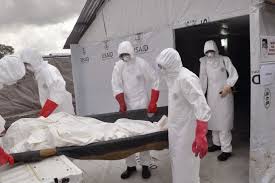

Ebola Deeply founding member Jon Gosier has been blogging from the Milken Institute School of Public Health in Washington, D.C., which is hosting “The Ebola Outbreak: Challenges and Next Steps for the Future” Global Health Forum this week. In the first of several blog posts, he reports on preparations for the post-Ebola fight.
Although Ebola is no longer making the front pages of the international media, it still very much has the attention of the public health community. This was particularly apparent on January 14–15th at “The Ebola Outbreak: Challenges and Next Steps for the Future” Global Health Forum. The event gathered some of the leading minds in the public health community to discuss the current state of global Ebola prevention, response and containment strategies.
“Liberia is our front yard, Guinea is our back yard,” said Madina Rahman, deputy minister of health, Sierra Leone, referring to the fact that her country can’t ignore the plight, even though it has been widely reported that the number of new cases is slowing. She says responders must remain resilient because even if the outbreak is contained, the effects will persist for years.
“The post–Ebola fight is going to be even bigger than the post-Civil War fight,” Rahman said to the roomful of activists, epidemiologists and African diplomats who had gathered at the Milken Institute.
At issue is the fact that kids in Sierra Leone, Guinea and Liberia have had to avoid school for nearly a year. Jobs have been lost and entire countries have had their economies significantly affected.
Dr. Dennis Carroll, the director of the U.S. Agency for International Development’s (USAID) Avian Influenza and Other Emerging Threats Unit, pointed out just how much these countries have suffered. “In 2013, Liberia’s projected Gross Domestic Product (GDP) growth for 2014 going into 2015 was widely assumed to be 7 percent. Post-Ebola it’s actually 0 percent.”
GDP is an indicator that measures a country’s ability to generate revenue from the products and services offered by its citizens. Slow GDP growth translates to a sluggish economy, which translates to increased unemployment and an increase in poverty.
Prior to the Ebola outbreak, the African continent’s GDP growth was projected to accelerate to 5.0 percent in 2014 and 5.1 percent in 2015, on the back of continuing commodity prices, domestic demand and improving governance. It’s too early for most economists to calculate the impact of Ebola on the continent’s GDP, but the threat looms.
In October of 2014 the World Bank released a report which estimated that the total cost of the outbreak to West Africa could reach upward of $33 billion. That’s a potential economic impact that is more than two times the size of the economies of the three primarily affected countries.
Carlos Lopes, the executive secretary of the United Nations Economic Commission on Africa, disputed the number at the time, placing the potential impact at $13 billion. The World Bank report was updated in December and held fast to the same projection, but conceded that it could also be as low as $3.8 billion. “These scale estimates of potential impact remain valid: The epidemic is not yet under control,” says the author in the updated version.
The chart below takes the loss-of-income numbers represented in the World Bank’s assessment and visualizes three potential scenarios: a worst-case scenario for 2015 (High Ebola), a milder scenario for 2015 (Low Ebola) and short-term projections for 2014 based on observations at the time (the chart was published in September of last year).
Whatever the economic cost, the ripple effects are abundantly clear. Poverty economist and statistician Kristen Himelein affirmed this in her own talk at the Milken Institute. She specializes in measuring what she calls the “quantifiable tertiary impact” of events such as the Ebola outbreak on poor and vulnerable countries.
In Sierra Leone, she says, there’s been a 9 point fall in employment, a tripling of temporary business closures and over 9,000 waged jobs lost. She says a number of unexpected tangentially related outcomes have stemmed from the Ebola outbreak as well – primarily that of food insecurity, which is at a high nationwide in Sierra Leone, as well as in Liberia, where citizens are having to tap into what would normally be stock for next year due to the crippled economy. If businesses are closed, they can’t purchase goods as they normally would, which means they are running on dwindling supplies with little hope of returning to their old methods for restocking.
Abebe Selassie, deputy director of the Africa Department at the International Monetary Fund (IMF), said that prior to the Ebola outbreak, “from 2009 to 2015, Sierra Leone was regarded as one of the 10 fastest-growing countries in the world,” driving home the point. Then, pre-Ebola, GDP growth was in the double digits. Current estimates have GDP growth reduced to 4 percent, less than half of what it was. Neighboring Liberia’s projected growth was 7 percent GDP growth, post-Ebola it’s 0 percent. Guinea also sits at 0 percent, down from 4.5 percent pre-Ebola.
In one of the final talks of the conference, Robert Soreson, deputy director of the Office of International Health and Biodefense at the U.S. Department of State, summed up the efforts of all in attendance: “Part of what we’re trying to do is help get these countries back to where they were before the 2014 Ebola crisis.”
Jon Gosier is the founder of Appfrica, a technology company that supports NGOs and multinational companies doing work across Africa. He is also a member of the Ebola Deeply founding team.


